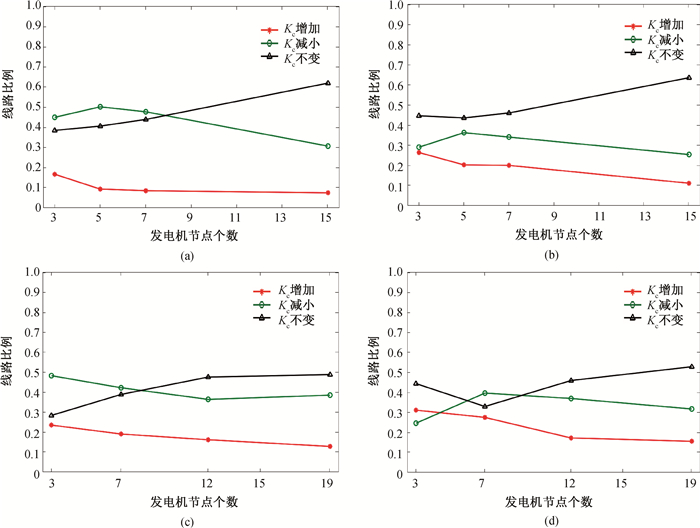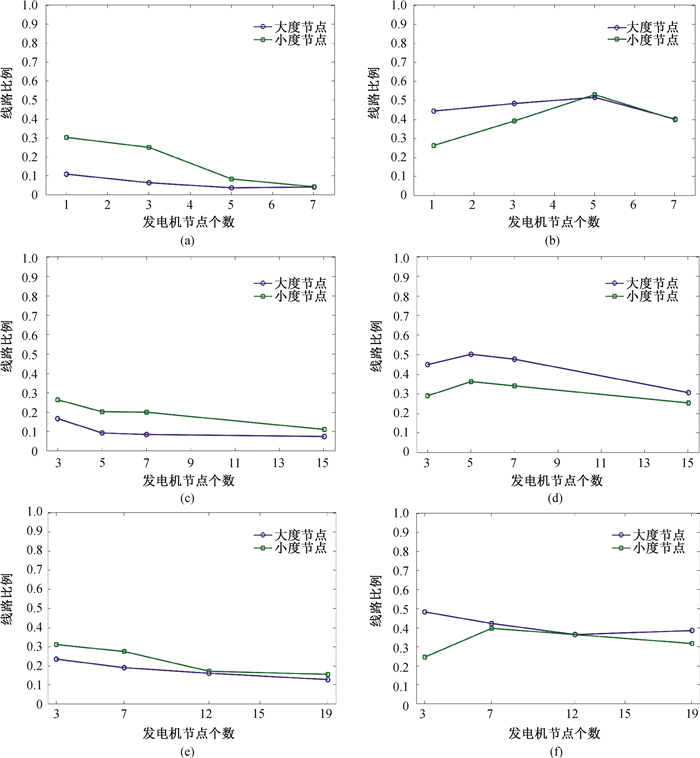Chinese Journal of Computational Physics ›› 2023, Vol. 40 ›› Issue (6): 770-778.DOI: 10.19596/j.cnki.1001-246x.8653
Previous Articles Next Articles
Beibei SHAO( ), Yanli ZOU(
), Yanli ZOU( ), Shaoyan HONG, Chanjuan LIANG
), Shaoyan HONG, Chanjuan LIANG
Received:2022-10-18
Online:2023-11-25
Published:2024-01-22
Contact:
Yanli ZOU
CLC Number:
Beibei SHAO, Yanli ZOU, Shaoyan HONG, Chanjuan LIANG. Study on Braess Paradox of Power Grid Based on Complex Network Topology[J]. Chinese Journal of Computational Physics, 2023, 40(6): 770-778.
Add to citation manager EndNote|Ris|BibTeX
URL: http://www.cjcp.org.cn/EN/10.19596/j.cnki.1001-246x.8653
| 新增传输线路编号 | 稳态频偏 | 临界同步耦合强度 |
| 原网络 | 0.0 | 2.3 |
| (1, 3) | 0.0 | 2.3 |
| (1, 4) | 0.0 | 2.2 |
| (2, 7) | 2.6 | 2.4 |
| (3, 10) | 2.6 | 2.5 |
| (3, 14) | 0.0 | 2.2 |
| (5, 8) | 0.0 | 2.3 |
| (5, 11) | 2.6 | 2.5 |
| (6, 8) | 0.0 | 2.0 |
| (8, 14) | 0.0 | 1.9 |
Table 1 The steady state frequency offset and the critical synchronous coupling strength of the original network of IEEE14 system and the network after the addition of some transmission lines
| 新增传输线路编号 | 稳态频偏 | 临界同步耦合强度 |
| 原网络 | 0.0 | 2.3 |
| (1, 3) | 0.0 | 2.3 |
| (1, 4) | 0.0 | 2.2 |
| (2, 7) | 2.6 | 2.4 |
| (3, 10) | 2.6 | 2.5 |
| (3, 14) | 0.0 | 2.2 |
| (5, 8) | 0.0 | 2.3 |
| (5, 11) | 2.6 | 2.5 |
| (6, 8) | 0.0 | 2.0 |
| (8, 14) | 0.0 | 1.9 |
| 系统 | 总节点数 | 连边数 | 网络节点平均度 |
| IEEE14 | 14 | 20 | 2.857 1 |
| IEEE30 | 30 | 41 | 2.733 3 |
| IEEE39 | 39 | 46 | 2.359 0 |
Table 2 Three kinds of standard test system characteristics parameters
| 系统 | 总节点数 | 连边数 | 网络节点平均度 |
| IEEE14 | 14 | 20 | 2.857 1 |
| IEEE30 | 30 | 41 | 2.733 3 |
| IEEE39 | 39 | 46 | 2.359 0 |
| 14节点网络 | ||||
| 发电机节点个数 | 1 | 3 | 5 | 7 |
| 负载节点个数 | 13 | 11 | 9 | 7 |
Table 3 Allocation of the number of generators and load nodes in a 14-node network
| 14节点网络 | ||||
| 发电机节点个数 | 1 | 3 | 5 | 7 |
| 负载节点个数 | 13 | 11 | 9 | 7 |

Fig.2 Topology of large degree nodes as generators (a), (b), (c) and (d) corresponding to a network with one, three, five and seven generator nodes, respectively

Fig.3 Topology of small degree nodes as generators, (a), (b), (c) and (d) corresponding to a network with one, three, five and seven generator nodes, respectively

Fig.4 The proportion of lines with Kc increasing, decreasing or unchanging after adding a new transmission line to a 14-node network varies with the number of generator nodes (a) large degree nodes as generators in a 14-node network; (b) small degree nodes as generators in a 14-node network
| 30节点网络 | ||||
| 发电机节点个数 | 3 | 5 | 7 | 15 |
| 负载节点个数 | 27 | 25 | 23 | 15 |
Table 4 Allocation of the number of generators and load nodes in a 30-node network
| 30节点网络 | ||||
| 发电机节点个数 | 3 | 5 | 7 | 15 |
| 负载节点个数 | 27 | 25 | 23 | 15 |
| 39节点网络 | ||||
| 发电机节点个数 | 3 | 7 | 12 | 19 |
| 负载节点个数 | 36 | 32 | 27 | 20 |
Table 5 Allocation of the number of generators and load nodes in a 39-node network
| 39节点网络 | ||||
| 发电机节点个数 | 3 | 7 | 12 | 19 |
| 负载节点个数 | 36 | 32 | 27 | 20 |

Fig.5 The proportion of lines with Kc increasing, decreasing or unchanging after adding a new transmission line to a 30-node or a 39-node network varies with the number of generator nodes (a)large degree nodes as generators in a 30-node network; (b)small degree nodes as generators in a 30-node network; (c)large degree nodes as generators in a 39-node network; (d)small degree nodes as generators in a 39-node network

Fig.6 The proportion of lines with Kc increasing and decreasing varies with the number of generators after adding a new transmission line in 14, 30, and 39-node networks, where generators are on large degree nodes or small degree nodes, respectively (a), (c) and (e) denote the proportion of lines with Kc increasing; (b), (d) and (f)denote the proportion of lines with Kc deceasing ((a) and (b)14-node network. (c) and (d)30-node network. (e) and (f)39-node network)
| 1 |
BRAESS D . Vber ein paradoxon aus der verkehrsplanung[J]. Mathematical Methods of Operational Research, 1968, 12 (1): 258- 268.
DOI |
| 2 | ZHAO C X . Braess' paradox and robustness of traffic network under dynamic equilibrium[J]. WSEAS Transactions on Systems and Control, 2017, 12, 288- 296. |
| 3 |
赵春雪, 傅白白, 王天明. 拥挤交通网络的Braess'悖论现象[J]. 交通运输系统工程与信息, 2012, 12 (4): 155- 160.
DOI |
| 4 |
MA J , LI D W , C L , et al. Link restriction: Methods of testing and avoiding Braess paradox in networks considering traffic demands[J]. Journal of Transportation Engineering, 2018, 144 (2): 04017076.
DOI |
| 5 |
WANG A H , TANG Y H , MOHMAND Y T , et al. Modifying link capacity to avoid Braess paradox considering elastic demand[J]. Physica A: Statistical Mechanics and Its Applications, 2022, 605, 127951.
DOI |
| 6 |
COLETTA T , JACQUOD P . Linear stability and the Braess paradox in coupled Oscillators networks and electric power grids[J]. Physical Review E, 2016, 93 (3): 032222.
DOI |
| 7 | 张玥, 谢光龙, 张全, 等. 美国得州2 ·15大停电事故分析及对中国电力发展的启示[J]. 中国电力, 2021, 54 (4): 192-198+206. |
| 8 | 卢恩, 鲁晓军, 龙霏, 等. 电力系统停电风险评估指标及方法[J]. 电力自动化设备, 2015, 35 (3): 68- 74. |
| 9 | WITTHAUT D , TIMME M . Nonlocal failures in complex supply networks by single link additions[J]. The European Physical Journal B, 2013, 86 (9): 1- 12. |
| 10 |
CHAO Y , YI C , LI P , et al. Impact of the network structure on transmission dynamics in complex networks[J]. IFAC Proceedings Volumes, 2013, 46 (13): 218- 223.
DOI |
| 11 |
CETINAY H , KUIPERS F A , Van MIEGHEM P . A topological investigation of power flow[J]. IEEE Systems Journal, 2018, 12 (3): 2524- 2532.
DOI |
| 12 |
FAZLYAB M , DÖRFLER F , PRECIADO V M . Optimal network design for synchronization of coupled oscillators[J]. Automatica, 2017, 84, 181- 189.
DOI |
| 13 |
TCHAWOU T E B , GOMILA D , PERE C , et al. Curing Braess' paradox by secondary control in power grids[J]. New Journal of Physics, 2018, 20 (8): 083005.
DOI |
| 14 |
YANG L X , JIANG J , LIU X J . Influence of edge additions on the synchronizability of oscillatory power networks[J]. Communications in Nonlinear Science and Numerical Simulation, 2016, 41, 11- 18.
DOI |
| 15 |
YANG L X , JIANG J . Impacts of link addition and removal on synchronization of an elementary power network[J]. Physica A: Statistical Mechanics and Its Applications, 2017, 479, 99- 107.
DOI |
| 16 | KAISER F N. Resilience of power grids and other supply networks: Structural stability, cascading failures and optimal topologies[D]. Koln: Universität zu Köln, 2022. |
| 17 |
ZOU Y L , WANG R R , GAO Z . Improve synchronizability of a power grid through power allocation and topology adjustment[J]. Physica A: Statistical Mechanics and Its Applications, 2020, 548, 122956.
DOI |
| 18 |
ZOU Y L , L H Q . Study on power grid partition and attack strategies based on complex networks[J]. Frontiers in Physics, 2022, 9, 790218.
DOI |
| 19 | 汪小帆, 李翔, 陈关荣. 复杂网络理论及其应用[M]. 北京: 清华大学出版社, 2006. |
| 20 | 蔡泽祥, 王星华, 任晓娜. 复杂网络理论及其在电力系统中的应用研究综述[J]. 电网技术, 2012, 36 (11): 114- 121. |
| 21 | 魏震波, 苟竞. 复杂网络理论在电网分析中的应用与探讨[J]. 电网技术, 2015, 39 (1): 279- 287. |
| 22 | LI H Q , ZOU Y L , ZHANG S Z , et al. Robustness of power grids structure and braess paradox phenomenon: A complex network theory study[J]. Chinese Journal of Computational Physics, 2021, 38 (4): 470- 478. |
| 23 | ZOU Y L , WANG R R , WU L J , et al. Optimization of synchronization performance in power grids with local order parameters[J]. Chinese Journal of Computational Physics, 2019, 36 (4): 498- 504. |
| 24 | FILATRELLA G , NIELSEN A H , PEDERSEN N F . Analysis of a power grid using a Kuramoto-like model[J]. European Physical Journal B Condensed Matter, 2008, 61 (4): 485- 491. |
| 25 | ZHANG S Z , ZOU Y L , TAN S Y , et al. Study of Braess paradox in an interconnected power grid based on complex network theory[J]. Chinese Journal of Computational Physics, 2022, 39 (2): 233- 243. |
| 26 | GILBERT E N . Random graphs[J]. The Annals of Mathematical Statistics, 1959, 30 (4): 1141- 1144. |
| [1] | Tao FU, Long WU, Chenguang LI. Site-bond Percolation Modeling of Real Networks: Generating Function Method [J]. Chinese Journal of Computational Physics, 2022, 39(2): 212-222. |
| [2] | Shaoze ZHANG, Yanli ZOU, Shuyi TAN, Haoqian LI, Xinyan LIU. Analysis of Braess Paradox in an Interconnected Power Grid Based on Complex Network Theory [J]. Chinese Journal of Computational Physics, 2022, 39(2): 233-243. |
| [3] | Haoqian LI, Yanli ZOU, Shaoze ZHANG, Xinyan LIU, Shuyi TAN. Robustness of Power Grids Structure and Braess Paradox Phenomenon: A Complex Network Theory Study [J]. Chinese Journal of Computational Physics, 2021, 38(4): 470-478. |
| [4] | LIU Lihua, WEI Duqu, ZHANG Bo. Synchronization Control of Chaos in Complex Motor Networks with Small-world Topology Based on Dynamic Relaying [J]. CHINESE JOURNAL OF COMPUTATIONAL PHYSICS, 2018, 35(6): 750-756. |
| [5] | WANG Yi, ZOU Yanli, HUANG Li, LI Ke. Key Nodes Identification of Power Grid Considering Local and Global Characteristics [J]. CHINESE JOURNAL OF COMPUTATIONAL PHYSICS, 2018, 35(1): 119-126. |
| [6] | AN haigang. Linkage Fluctuation in Double Variables of Time Series Based on Complex Networks [J]. CHINESE JOURNAL OF COMPUTATIONAL PHYSICS, 2014, 31(6): 742-750. |
| [7] | FAN Wenli, LIU Zhigang. An Evaluation Method for Node Importance Based on Efficiency Matrix [J]. CHINESE JOURNAL OF COMPUTATIONAL PHYSICS, 2013, 30(5): 714-719. |
| [8] | TANG Shengxue, CHEN Li, HUANG Jiaoying. Modeling and Identification of Associated Complex Networks [J]. CHINESE JOURNAL OF COMPUTATIONAL PHYSICS, 2012, 29(2): 308-316. |
| [9] | DANG Huixue, CHEN Zhimin, YANG Zhichun. Merging of Vortex Pair at Different Separating Distances [J]. CHINESE JOURNAL OF COMPUTATIONAL PHYSICS, 2008, 25(3): 259-262. |
| Viewed | ||||||
|
Full text |
|
|||||
|
Abstract |
|
|||||
Copyright © Chinese Journal of Computational Physics
E-mail: jswl@iapcm.ac.cn
Supported by Beijing Magtech Co., Ltd.
